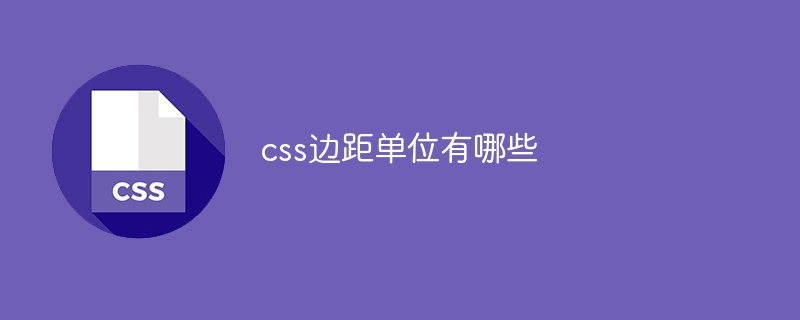
css margin units include px, %, em, rem, vw and vh, vmin and vmax, ex and ch, pt and pc, etc. Detailed introduction: 1. px, fixed length unit; 2. %, the unit of margin is calculated relative to the width of the parent element; 3. em, the unit of margin is calculated relative to the font size of the element; 4. rem, Units for calculating margins relative to the font size of the root element; 5. vw and vh, units relative to viewport width and viewport height; 6. vmin and vmax, etc.

# Operating system for this tutorial: Windows 10 system, Dell G3 computer.
CSS margin units have the following types:
Pixel (px): Pixel is one of the most commonly used margin units. It is a fixed length unit that represents a point. In CSS, you can set the margins of an element using pixel values, for example: margin: 10px.
Percent (%): Percent is the unit used to calculate margins relative to the width of the parent element. For example, if the width of the parent element is 200px and you set the margin to 10%, the margin will be 20px. Percentage units can be used to set horizontal and vertical margins, for example: margin-top: 10%.
em: em is the unit used to calculate margins relative to the element's font size. For example, if the font size of an element is 16px and the margin is set to 2em, the margin will be 32px. The em unit can also be used to set horizontal and vertical margins, for example: margin-left: 1.5em.
rem: rem is the unit used to calculate margins relative to the font size of the root element. The root element is usually an HTML element. Unlike the em unit, the value of the rem unit is not affected by its parent element. For example, if the font size of the root element is 16px and the margin is set to 2rem, the margin will be 32px.
vw and vh: vw and vh are units relative to the viewport width and viewport height. The viewport is the visible area of the browser window or device screen. vw represents the percentage of the viewport width, and vh represents the percentage of the viewport height. For example, if the viewport width is 1000px and the margins are set to 10vw, the margins will be 100px.
vmin and vmax: vmin and vmax are percentages relative to the smaller or larger value of the viewport width and viewport height. vmin will be calculated based on the smaller size in the viewport, and vmax will be calculated based on the larger size in the viewport. For example, if the viewport width is 1000px, the viewport height is 800px, and the margins are set to 10vmin, the margins will be 80px.
ex and ch: ex and ch are the units in which margins are calculated relative to the "x" height and "0" character width of the font. These units are typically used to set margins associated with a specific font. For example, if the font's "x" height is 10px and the margins are set to 2ex, the margins will be 20px.
pt and pc: pt and pc are printing units, used to set margins when printing. pt means 1/72 inch, pc means 12 points (1 point equals 1/72 inch). These units are rarely used in web development and are more commonly found in the printing and publishing world.
The above are common margin units in CSS. According to specific needs and design requirements, choosing appropriate units to set the margins of elements can make the page layout more flexible and controllable.
The above is the detailed content of What are the css margin units?. For more information, please follow other related articles on the PHP Chinese website!